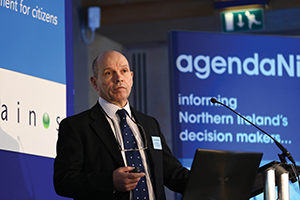DARD’s digital action plan
The Department of Agriculture and Rural Development’s Digital Services Director Paul McGurnaghan discusses the department’s digital action plan for public services.
 In 2014 the Department of Agriculture and Rural Development launched its digital strategy. As the department’s Director of Digital Services, Paul McGurnaghan explains, the goal of the strategy is to increase the uptake in the use of the department’s digital services to 80 per cent by 2018 and 100 per cent by 2020.
In 2014 the Department of Agriculture and Rural Development launched its digital strategy. As the department’s Director of Digital Services, Paul McGurnaghan explains, the goal of the strategy is to increase the uptake in the use of the department’s digital services to 80 per cent by 2018 and 100 per cent by 2020.
“To achieve this target we began with the approach of delivering digital services that are so good people who can use them will want to use them,” explains McGurnaghan. To achieve this the department has designed its digital services from a customer perspective with a focus on quality. While McGurnaghan admits cost is a driving factor, he remains adamant that when digital services are implemented correctly, they provide better services for customers.
The department has five key goals. It aims to help maximise income for farmers, encourage wider rural development, improve the environment, focus on animal health and deliver services more effectively. Effective digital services can help achieve all of these goals.
Services
At present DARD has 57 transactional services online. These services are responsible for around 400,000 transactions a year carried out by 11,200 farm businesses. The animal and public health information system (APHIS), the Single Application Form (SAF) and the online mapping system are the most frequently used services. APHIS provides a full suite of services around animal traceability and disease management, the Single Application Form allows farmers to easily apply for EU grants and the online mapping system allows farmers to report any changes to their boundaries or merging of fields.
All famers must tag bovine animals with two tags, one in each ear for identification purposes. Farmers have to notify the department of the births and deaths of any of these animals and can do so online, by telephone or via postal forms.
McGurnaghan explains that the digital application for registering births online is ‘simple and significant.’ In developing this service the department worked closely with farmers to make sure it suits their needs, with built in validations to eliminate errors. Farmers, for example, can only register newborns to a mother who is actually in their herd and has not had a birth registered in the previous nine months. Once farmers register those animals they have access to a range of different services including viewing information on herd lists and the results of herd tests as well as the ability to query the details stored on file. “It is an easy to use service but our challenge is to get more people to use it, acknowledges McGurnaghan. “We started the development of this process in 2002 and we now have around 60 per cent of births and registrations taking place online. In total this year we expect around 540,000 registrations but we still have a significant challenge to get to our 80 per cent target. To achieve this goal we will need to increase its use by around 7 per cent per annum.”
Reaching targets
Throughout the development of the digital strategy one of its core guiding principles was to understand customers and design services around them. To deliver on this principle the department is focused on building its internal capability and increasing capacity within the wider public sector to deliver these digital services.
During the development of these services, DARD has been able to call on some of the most experienced people across the public sector, supported by private sector partners. It is this approach that McGurnaghan credits for the delivery of simple applications that mean the majority of users can achieve the outcomes they expect to achieve at the first time of asking unaided. An end-to-end design process has also been adopted that will continuously improve the service based on user feedback, benchmarking and analytics.
Determined to realise their service usage goals by 2018, the department has split their customers into three subsections: those can use the digital services and do, those who cannot use the digital services and those who could and should but won’t. By using broadband availability surveys the department hopes to identify customers in each of these categories and target the delivery of further initiatives designed to increase the use of these services.
One of these initiatives is Assistant Digital. The department is working closely with the Department of Finance and Personnel’s Digital Transformation Service to support people who genuinely can’t use the services due to factors such as a lack of internet access or computer illiteracy. A service designed to support people who could use the service but choose not to is also present as the department recognises that change can be scary and some will need a bit of help to start using the service.
Another of the processes adopted to make the system easier to use is standardisation. Using the same model as NI Direct, the department has a standardised interface for customers across all online applications. This standardisation has had a very positive result and in 2015, 98 per of those who used online services completed their transactions and 96 per cent said they would use the service again. “We are also concentrating our efforts on becoming a data driven organisation, we are starting to make much more extensive use of analytics and feedback from customers to develop a dashboard that allows us to identify where we need to make further improvements,” said McGurnaghan who also praises the department’s AGILE approach to service development.
“This is something that we have been using for a year and a half and have used it in the Single Application Form process. It has to be disciplined, we have four big AGILE teams who are developing the scheme and we wouldn’t have been able to make CAP payments to farmers on time this year, achieving the best payment performance in the UK, if we hadn’t adopted this approach.”
While the services are present and much effort has gone into their development the department is also aware that a business transformation will be necessary to ensure the success of digital services. “We can’t just put a digital front end on our services. That will only end up costing more in the long run,” states McGurnaghan. “What we are trying to do is standardise our digital services so that they are the same both internally and externally. There should be no difference between internal users and external users and their agents. They should be able to access the same validation and functionality and that will significantly cut the costs of developing IT systems. By introducing a single standardised digital platform we will save a lot of time and effort,” he concludes.





